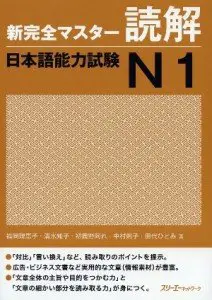Last year before taking the N1 for the second time, I had a 5 month plan that religiously stuck to. I managed to work my way through all 4 books that I wanted to get through in that time. I went through the So-Matome N1 Listening and Reading books, as well as the New Kanzen Master Listening and Reading books.
The last book that I went through before my month of sword sharpening was the New Kanzen Master Reading Comprehension book for N1. I didn’t do the N2 version of this book, but now, having finished the N1 level version, I wish I had. This is a pretty thick and useful book.
The New Kanzen Master series tends to be more difficult than the exam, especially their grammar books. But, this book seemed to be just about the right level, not easier, not harder. Some of the sections, like the ones that go over the business letters seemed laughably easy to me, but then again maybe that is because I have to read a lot of business letters and things at work and at home.
The New Kanzen Master book takes a different approach to the So-Matome N1 book. Instead of focusing on phrases and vocabulary, NKM focuses more on general reading skills and how to get the answer they are looking for. It walks you through what to do to comprehend the reading passages well.
Format of the Book
The book is divided up into 3 main chapters. The first 2 chapters cover specific strategies for different kinds of reading passages. These go over things like how to answer questions that ask for examples, or paying attention to contrasting statements in the reading. The 3rd chapter goes over real questions that are formated like the ones on the test. Finally, there is the obligatory practice test at the end to see how you are doing.
The first 2 chapters are great because it will walk you through one full-sized example before giving you more passages and questions to practice with. This is better than the So-Matome approach in some ways because you are working with a longer passages and so you can practice more general comprehension skills. For example, you can practice skimming to get a general idea of the meaning of the passage before going back and answering the questions about specific points.
I also like how each answer is explained in the answer key. So, if you get an answer wrong, it tells you specifically why you got it wrong. This really helps you to start to understand the kinds of mistakes you are making with your reading comprehension as well as what tricks the test will most likely have on it and how to look out for them.
Almost feel like the team that is writing the grammar book could learn a thing or two from those that wrote this book. The grammar book for the NKM series has virtually no explanations for why an answer is write or wrong.
What I like about It
There is a lot of reading practice smashed into this book at a pretty good price. There are 68 reading passages (with about 2 or 3 questions each) plus the practice test. You will still need to do reading outside of this to improve your Japanese and to prepare for the test, but with this much material you’ll be pretty prepared for what to expect on the exam.
I love the explanations too. I can’t tell you how much that has helped me narrow down and target my comprehension mistakes. I will most likely work my way through this book again at some point just to refocus and make sure I’ve improved upon my mistakes.
What I don’t like About It
Surprisingly, some of the questions in the book are just a little too easy compared to the real exam. In particular the information retrieval questions (the last section of the reading part) are pretty easy and don’t take much time to answer. On the real exam, the questions for these questions are quite large and wordy (2 to 3 sentences long) and can take a lot of time to find the answer.
Overall
A great book and good preparation for the exam. If you have to choose between So-Matome and this book to prepare for the N1, I would probably choose this one over So-Matome. The main reason for that is the amount of material and also the amount of more general strategy that can help in every situation. The So-Matome goes over a few phrases and things that may not come up all the time, but are still pretty useful.
What’s your Take?
Have you used the New Kanzen Master N1 Reading Comprehension book? Did you like it? Let me know in the comments.













Dear Mac,
Thank you for this useful article.
You say “If you have to choose between So-Matome and this book to prepare for the N1, I would probably choose this one over So-Matome”. Oups, too late for me: I have already bought the “So-matome” book (good marketing idea : the funny cats in the “so-matome”, I love them …LOL) . After reading your article, I consider buying the “Kanzen master” too.
You mention that “Kanzen master” focuses more on general reading skills and how to get the answer they are looking for. Do you think it is more efficient for me to study the “Kanzen master” book first, and then practice with the “So-matome” book which focuses more on phrases and vocabulary? Or do you think there is no need to hurry and buy it now, that I should just go on with the “so-matome”?
what is your advice?
Thank you!
I do So-Matome first, and I would recommend doing the same the main reason being that in the last week of So-Matome there are some tips on how to make notes or ‘dissect’ a reading passage and you can practice that in the New Kanzen Master book after you have learned it in So-Matome if that makes sense.
Mostly though, N1 is a tough beast you will probably have to do at least both, and you might have to go back through both as well (or even buy another book). I’m thinking I might end up buying one more reading book for N1 before I’m finished. 🙂
Good luck!
Hello Mac,
Thank you for your advice, I have just has a closer look at week 6, indeed it seems very interesting and can be useful for any reading practice in Japanese.
Good luck to you too! 🙂
Thought I’d just add I have the N3 Kanzen book and thankfully it has explanations for the grammar points. I’ve also got the N2 version as well which doesn’t have any at all 🙁 Bit sad about that as I’m going to have to buy the Intermediate Dictionary but even then I won’t know for sure if the explanations are fitting a point in the Kanzen. I have the So-Matome for N3. I like the layout of the book but again there are grammar points without explanation. They include sample sentences translated but again I’m not confident I’m interpreting them correctly. I’ve just started using the ‘Tobira’ textbook so hopefully this will help me make progress in my studies.
Sorry should have said these are the grammar books.
Hi Barbara! I had kind of the same problems with Soumatome. The grammar they cover is really useful, but there’s not enough there to really feel confident that you understand it 100% after reading it. I used renshuu.org and the J-Gram website to look up each grammar point I didn’t understand and rip them apart until I figured them out. Some of the more difficult ones have comments at the bottom on nuances and common mistakes, so it can be pretty helpful. 🙂
Thanks for that 🙂 I’ll be sure to give it a try. I think your method is really useful as it will stop me from simply filling in gaps but actually use the structures for myself. Thanks:)